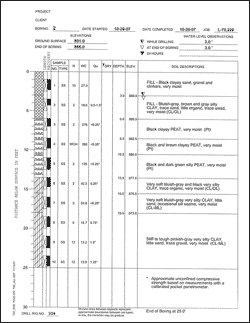Helical Piles for New Construction – Commercial and Industrial
Supporting Foundations and Structural Slabs
When encountering poor soil conditions on a building site it may be necessary to transfer the building loads to deeper more stable soils. Determining the most effective and economical solution to this problem will generally involve an investigation of the soil conditions which is typically done with a soil boring. An example of a soil boring is shown in Figure 1 to the right. As can be seen in this particular soil boring there is fill material located over peat on the building site. Adequate soils are not found until you reach a depth of approximately 20′.
Supporting building loads on deeper soils can be accomplished in several ways including:
- Removal of poor soil materials and replacement with properly compacted gravel. This is an economical solution when adequate soils are found within a few feet of the bottom of the footings.
- Driving steel, concrete, or timber piles. “Driving” refers to the process of pounding the piles into the ground with a crane mounted hammering device. This is a very economical solution when a lot of piles are required. It may not be a very effective solution if there are other buildings or structures nearby as the ground vibrations caused by the hammering may cause damage to those nearby structures.
- Drilled piers refers to the process of drilling a hole in the ground and filling it with concrete. When considering drilled piers, keep in mind that the material excavated from the hole may also have to be removed from the site. Soil condition may be poor enough that sleeving the drilled pier is required to prevent the hole from caving in. In some cases these sleeves are recovered as the concrete is placed in the hole. Drilled piers have been used for a long time with great success. Typically drilled piers become more economical as the number of piers required for the job increases and as loading requirements increase, as may be the case with multiple story steel or concrete buildings.
- Geopiers are stone filled drilled holes. Holes are drilled into the ground and then backfilled with stone which is compacted as it is placed. The placement and compaction of the stone consolidates the soil around the hole. This process may prove to be economical on larger projects. As with driven piles, ground vibrations caused by compaction of the stone fill may cause damage to nearby structures.
- Dynamic compaction refers to the compaction of soil by repeatedly dropping a large weight from a crane onto the ground. No material is placed in the ground and there is no excavated material to handle. This is effective only in certain soil conditions but can be very economical. As with driven piles and Geopiers, ground vibrations caused by compaction of the soil may cause damage to nearby structures.
- Helical piles are steel shafts with helixes welded to them. The Helical pile is installed by screwing it into the ground. The size of the shaft along with the size and number of helixes varies depending on the loading requirements and the soil conditions. This type of pile is very effective in areas where access is limited, where ground vibrations must be kept to a minimum, where soil conditions are very wet, and where the number of required piles can be a few as 1. Helical piles are not very effective or economical in situations where building loads are relatively high as may be the case with multiple story steel or concrete buildings. They may also not be very competitive in situations requiring a large number of piles.
We are capable and experienced with designing in all of the above discussed extended foundation systems but we install only one, the Helical pile.
In new construction we utilize the Helical pile to support foundation walls and concrete floor slabs in residential, commercial, and industrial buildings.
In existing construction where settlement has become a problem, we utilize the Helical pile to support concrete slabs but not the foundation walls. The reason for this is that the equipment required to spin the Helical piles into the ground forces the top of the Helical pile out away from the foundation wall so the pile ends up being driven into the ground at an angle under the foundation. This angle results in the building loads not acting vertically on the pile which results in bending forces being induced into the Helical pile. Because of this we prefer to utilize push piles to support existing foundations and Helical piles to support concrete slabs.
Concrete slabs supported on Helical piles must be designed and constructed as structural slabs. This requires the installation of reinforcing steel and in many cases concrete beams must be formed into the slab to transfer loads to the Helical piles.
Below are several photographs of a building supported on Helical piles. In this case the building has 24′ tall precast concrete exterior walls and a steel roof system. The soil boring shown in figure 1 is one of the borings taken at the site where this building was constructed. An existing building was located 10′ to the east, railroad tracks ran along the north side, and the building was being constructed in the middle of town. Therefore heavy ground vibrations could not be tolerated. All excavated material had to be hauled away from the construction site, therefore it was considered advantageous to keep excavations to a minimum. These factors, along with competitive pricing, contributed to selecting the Helical pile as the solution to supporting the building.

